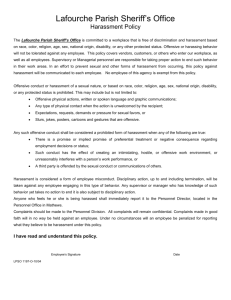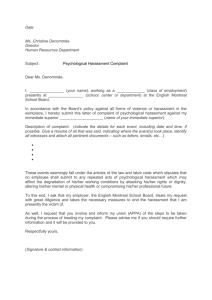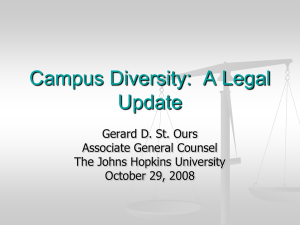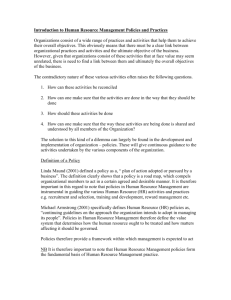Trying the Sexual Harassment Case to a Jury
advertisement
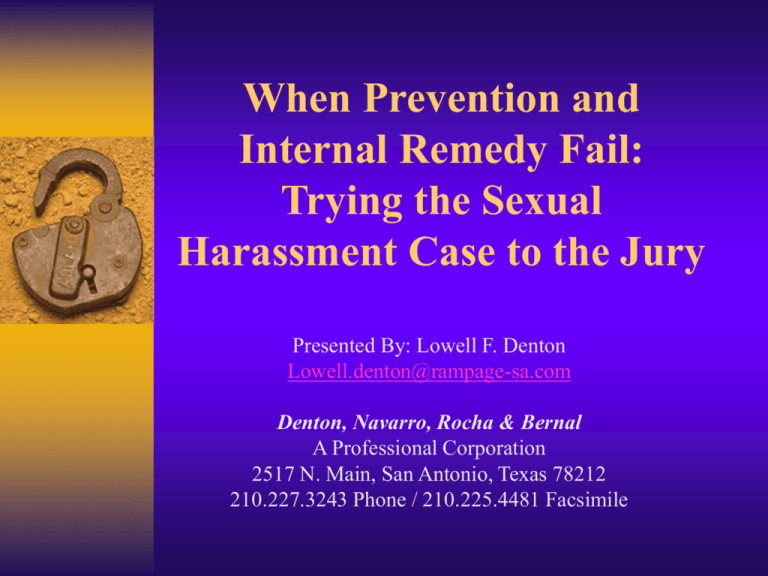
When Prevention and Internal Remedy Fail: Trying the Sexual Harassment Case to the Jury Presented By: Lowell F. Denton Lowell.denton@rampage-sa.com Denton, Navarro, Rocha & Bernal A Professional Corporation 2517 N. Main, San Antonio, Texas 78212 210.227.3243 Phone / 210.225.4481 Facsimile Difference Between Violation of Law and Violation of Policy May have a violation of policy but not a violation of law Jury’s understanding of this Policy designed to promote efficiency in work place, not to make conduct unlawful City Policy Foster good working conditions promoting efficiency and productivity Prevention of harassment Memorializing that harassment will not be tolerated may go far toward defeating liability Prompt response Policy should be communicated Policy should be enforced Elements of a Good City Policy Definition of harassment with examples of offensive conduct Statement it will not be tolerated or condoned Anti-retaliation statement Request for report of conduct asap, with a clear and neutral procedure for making a report to someone in a position to assist the complainant (alternative process if it is against a person’s supervisor) Distinguish violation of law from a violation of policy The Law Title VII: an employer may not “discriminate against any individual with respect to his compensation, terms, conditions, or privileged of employment, because of such individual’s race, color, religion, sex, or national origin: Texas Labor Code creates the equivalent under state law 22-Year History Meritor Savings Bank, VSB v. Vinson, 477 U.S. 57 (1986) Decided by U.S. Supreme Court Found that sexual harassment, which creates a “hostile or abusive work environment” is an actionable claim under Title VII Prima facie case (1) (2) belong to a protected class subjected to unwelcome sexual harassment (3) harassment complained based on sex (4) harassment affected a term, condition, or privilege of employment Prima facie case: protected class Includes: Gender Religion Age Race National Origin Disability Areas for Dispute Prima facie case: whether action was “unwelcome” “unwelcome in the sense it is unsolicited or unincited and is undesirable or offensive to the employee” EEOC Guidelines Emphasize that the trier of fact must determine the existence of sexual harassment in light of: “the record as a whole” and “the totality of the circumstances, such as the nature of the sexual advances and the context in which the alleged incidents occurred” 29 C.F.R. Section 1604.11 Indicative of unwelcomeness Told to stop Told inappropriate Leave me alone Any response at all What is viewed by a third party Prima facie case: whether action “affected term, condition or privilege of employment” Can be shown by: quid pro quo: suffered “tangible employment action” as a result of harassment” hostile environment: no “tangible employment action” “tangible employment action” Significant change in employment status, such as hiring, firing, failing to promote, reassignment with significantly different responsibilities, or a decision causing a significant change in benefits Burlington Indus. v. Ellerth, 524 U.S. 742 (1998) Effect of proving quid pro quo: Employer is always held to be vicariously liable for proven harassment by a supervisor in a quid pro quo action Differs from hostile environment case: to establish employer’s vicarious liability the employee must show that the alleged harassment was either severe or pervasive Actionable hostile environment claim Must Be: Objectively offensive (a reasonable person would find it hostile or abusive) Subjective offensive (the employee did in fact perceive it to be hostile or abusive) Circumstances that determine whether severe or pervasive Frequency Degree to which conduct is physically threatening or humiliating Degree to which the conduct interferes unreasonably with an employee’s work performance Note: Importance of third party testimony Affirmative Defense Even if determined to be a prima facie case of hostile environment. No liability for employer if able to demonstrate both: (1) Employer exercised reasonable care to prevent and correct promptly any sexually harassing behavior AND (2) that the employee unreasonably failed to take advantage of any preventative or corrective opportunities provided by the employer to avoid harm otherwise Employee must comply with City’s own policy on reporting workplace harassment Policy is intended to enforce the goals of Title VII “to encourage the creation of antiharassment policies and effective grievance mechanisms” Williamson v. City of Houston, 148 F.3d 462, 466-67 (5th Cir. 1998) Prompt Remedial Action City must comply with City’s own policy Must be reasonably calculated to end the harassment--Did it stop? Action must be taken by one with “authority to address the harassment problem” Williamson, 148 F.2d at 466. Factual Investigation as Proof for Affirmative Defense Did the employer: – Remove accuser from the situation if necessary (be sensitive to potential retaliation complaints) – Policy to investigate quickly, effectively and discreetly – Cannot guarantee confidentiality (open records and defense purposes) – Need to consider both the accuser’s and accused’s interests (request for any documents or witnesses from both) – Address harassment claims consistently Remedial Action Did the employer: – Act promptly and effectively – Respond to any policy violations – Restore any employment opportunities missed due to harassment – Ensure the harasser does not repeat the offensive conduct – Act consistently


